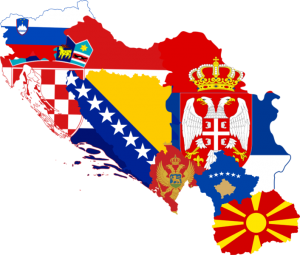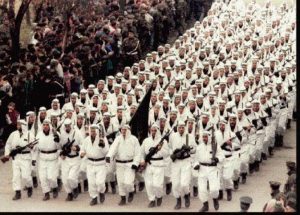
Views: 1785
 Split, Croatia: “Kill Serbs” written on the car arrived from Serbia
Split, Croatia: “Kill Serbs” written on the car arrived from Serbia
Territorial imperialism of the HDZ’s Croatia
The fact was that all ultranationalistic parties and organizations in the 1990s struggled for the creation of a Greater Croatia according to the principle of the ethnographic, historical and even natural rights. In all of those concepts, Bosnia-Herzegovina was seen as an integral part of united Croatia. There were, in principle, two concepts of united Croatia:
- A minimal concept of Croatia within the borders of the Banovina Hrvatska as it was in the Kingdom of Yugoslavia in 1939−1941 (when a Greater Croatia as a separate and autonomous administrative territory became a state within a state).[1]
- A maximal concept of Croatia within the borders of the WWII NDH in 1941−1945 that included all Bosnia-Herzegovina and parts of Serbia inhabited by 6.663.157 citizens of whom 1/3 were the Orthodox Serbs.[2]
The cardinal point of the question of Croatia’s state borders involves Bosnia-Herzegovina as an indivisible part of any kind of the “natural Croatia”. All existed differences between the Croats and the Bosnian-Herzegovinian Muslims were considered as artificial and created by the Yugoslav authorities. The Muslims in Bosnia-Herzegovina were declared as the “purest Croats” according to the WWII Ustashi ideological pattern. In general, for the Croat politicians, academicians, and public workers, the Drina River was a demarcation line between the civilization and the barbarism, or between Europe and the Orient. The Serbs were considered as the proponents of the Byzantine-Ottoman Oriental anti-European culture, while the Croats and Slovenes were understood as the last bulwark of the European civilization in front of the Oriental primitivism. For all Croat nationalists, the Drina River was and is the border that the Serbs must not be allowed to cross as well the border of the “natural Croatia”. In some conceptions of the extraterritorial enlargement of Croatia, the territory of Serbia had to be restricted to the area around Belgrade only.[3] Nevertheless, Bosnia-Herzegovina and Croatia were considered to be the same land, people and blood of the same nation. Therefore, Croatia and Bosnia-Herzegovina have to be united into a single national state of the ethnic Croats. Croatia’s unification with Bosnia-Herzegovina was explained by ethnic, historical economic and even civilizational reasons as the historic mission of the Croat nation was seen to defend Europe from the Oriental despotism, i.e. from Serbia and the Serbs.
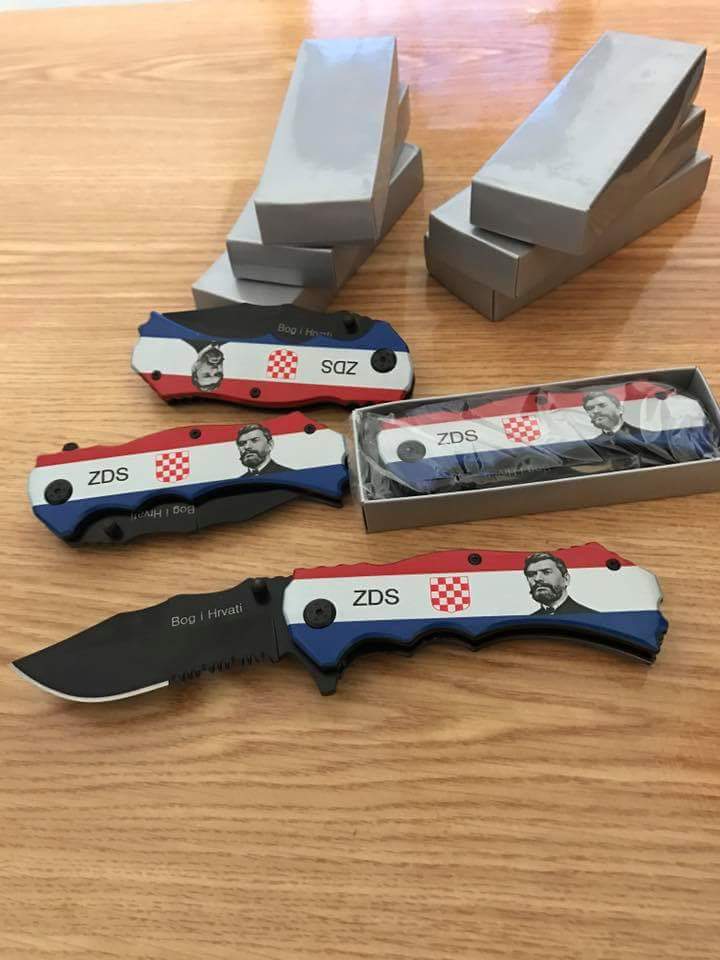 Nife of the present-day EuroCroatia. Legend: An inscription on the blade is “God and Croats”. Abbreviation ZDS iz “Za dom spremni” (Ready for Homeland) – the WWII Nazifascist Ustashi motto. The coat of arms is from the WWII Independent State of Croatia. The person is the mid-19th century “Father of Croats” – Dr. Ante Starčević, a racist ideologist of ethnically cleansed Croatia
Nife of the present-day EuroCroatia. Legend: An inscription on the blade is “God and Croats”. Abbreviation ZDS iz “Za dom spremni” (Ready for Homeland) – the WWII Nazifascist Ustashi motto. The coat of arms is from the WWII Independent State of Croatia. The person is the mid-19th century “Father of Croats” – Dr. Ante Starčević, a racist ideologist of ethnically cleansed Croatia
It is known and proved that Tudjman had a set of secret negotiations with Miloshevic to divide Bosnia-Herzegovina between Serbia and Croatia. Hence, the Dayton Accords on November 21st, 1995 on the final division of Bosnia-Herzegovina according to the mathematical formula of 51/49 percent can be seen as a practical implementation of their secret agreement sponsored by the U.S. administration of Bill Clinton.[4] A creation of an ethnically pure Croat portion of Bosnia-Herzegovina was a part of this Tudjman-Miloshevic’s deal and in order to achieve this goal the Croats practiced in 1993−1994 the policy of ethnic cleansing of the West Herzegovina and a part of the Central Bosnia within the territory of the Croat-proclaimed Herzeg-Bosnia with the capital in Mostar on the Neretva River.[5] The Croat-Muslim civil war in Bosnia-Herzegovina was halted in the spring of 1994 just due to the U.S. ultimatum to Zagreb: in order to liquidate the Republic of Serb Krajina and to reintegrate it into Croatia, the Croats had to unite their military forces in Bosnia-Herzegovina against the Serbs. Therefore, it was agreed in March 1994 a creation of the Croat-Muslim federation in Bosnia-Herzegovina that was advocated by Washington (the Washington Framework Agreement). In practice, even today, the Croat controlled part of Bosnia-Herzegovina is not under a virtual administration by the central authorities of Bosnia-Herzegovina in Sarajevo similar to the case of the Republic of Srpska. Nevertheless, Tudjman’s policy of the division of Bosnia-Herzegovina with the Serbs was opposed by all kinds of the Ustashi groups either in Croatia or Bosnia-Herzegovina as for them a whole territory of Bosnia-Herzegovina was indivisible part of a Greater Croatia as a national state of all and only ethnic Croats including and the Bosnian-Herzegovinian Muslims who were ideologically considered as the ethnohistorical Croats as well. The Ustashi organizations and parties advocated a common Croat-Muslim combat against the Serbs in Bosnia-Herzegovina but only after the creation of ethnically pure Croat Herzeg-Bosnia. In principle, they opposed the Dayton Accords as this agreement gave to Serbia a real possibility to cross the Drina River.
The “Serb Question” and its final solution
Undoubtedly, a question of the Serb existence on the “ethnohistorical” lands of the Croat nation was at least during the last hundred years a very fundamental element of any ultraright Croat ideology, party, organization or movement, but above all of the Ustashi, as the Orthodox Serb were seen and declared as the most dangerous “natural enemy” to both Croatia and the Croat people. The Anti-Serbism became, however, the main cornerstone of making the Croat national unity and gathering all Croats around a common focus of ethnopolitical coherence.[6] The Serbs were accused of the territorial expansionism, occupation of the Croat land and its exploitation at the time of the Kingdom of the Serbs, Croats and Slovenes (1918−1929), the Kingdom of Yugoslavia (1929−1941) and socialist Yugoslavia (1945−1991) as all of these three multiethnic states were proclaimed as a Greater Serbia. The Serbs and Serbia were seen as the main cause of all Croatia’s misfortunes and above all as the only obstacle for Croatia’s independence.[7] Croatia’s Government together with other right-wing nationalistic structures tried from the very beginning of the preparations for the proclamation of the new independence of Croatia in 1991 (the second Independent State of Croatia) formally, but unsuccessfully, to convince the Serbs and Serbia that there was no real “Serb Question” in Croatia and that the Serbs had nothing to fear in independent and democratic post-Yugoslav Croatia. However, for the majority of Serbs from both sides of the Drina River, it was completely clear that a newly independent Croatia will be just a replica of the WWII Nazi-Ustashi Independent State of Croatia in regard to the “Serb Question” just covered by declarative and formal democracy. It was visible for them either from the practical rehabilitation of the NDH in Tudjman’s Croatia and the harsh anti-Serb rhetoric by the officials or from the very fact that no one political party or official in Croatia did not want to discuss with the Serbs about their cultural and/or political autonomy.
A policy of opposing and hating the Serbs in the HDZ’s Croatia had political, confessional and moral connotation. To fight “natural enemies” was all the time one of the fundamental requirements of any nationalistic ideology. Hence, the national education system has to be rearranged on this way to teach the nation who, and why, is the national enemy and how the nation has to struggle against the enemy. In the case of Tudjman’s Croatia, the main national enemy ware proclaimed to be the Serbs. Subsequently, the Serb traces in Croatia had to be erased by different techniques including the ban of Cyrillic alphabet or cleansing Croatia’s libraries from the Serb authors. Nevertheless, a public vilification of the Serbs as a nation in Croatia had and its own racial dimension as it was exactly during the existence of the WWII NDH. Probably the most racist MP from the HDZ – Shime Djodan, made a very abusing remark on the Serb physiognomy during his speech in the Parliament. Usually, the Serbs were considered as a racially inferior having the “Byzantine” or/and “Turkish” blood as it was noticed, for instance in 1995, by the HDZ’s member Anton Vrdoljak, head of Croatia’s Radio Television (the HRT).[8] The political consequences of a Croat nationalistic picturing of the Serbs as a root of all evil in Croatia lead the nationalists to require the maximal restriction of political rights of the Serbs in Croatia including and the right to citizenship and therefore to vote. Such calling for political discrimination on the ethnic basis was, however, formally not presented in the official party’s statutes in which there was a proclamation of no discrimination on the basis on the national identity, as it was the case, for instance, with the HSP.[9] A leader of this party, Ante Djapic was quite clear about the position of the Serbs in the post-Yugoslav Croatia: “[the Serbs should] either bow down or get out of the way”.[10] Subsequently, all Croat nationalists firmly opposed any kind of political negotiations with Croatia’s (Krajina) Serbs, rejected their representation in the Parliament and arguing that the Serb Orthodox Church in Croatia has to be abolished and instead of it the Orthodox Church of Croatia should be established (like in the WWII NDH). Since the Croat military-police operation “Oluja” (Storm) of ethnic cleansing of the Krajina Serbs in August 1995, all Croat nationalistic parties, including above all the ruling HDZ, did everything in order to prevent the return of the Serb refugees (about 250,000)[11] to their homes. In order to achieve this goal, usually, three methods were used:
- Demolition of the Serb houses.
- Public announcing the Serb names as wanted war criminals.
- Physical attacking, or even killing, the Serb refugees.
Nevertheless, either the HDZ or other right-wing Croat parties never recognized the mass exodus of Krajina Serbs from Croatia in August 1995 as the ethnic cleansing as for them it was rather a free choice of the homeland as it was officially stated by the President Franjo Tudjman. Official Croatia as well never recognized the existence of the concentration camps for the Serbs in the 1990s on the territory of Croatia like it was in the Pakrac poljana, around Gospic, and in Sisak.[12] According to the Croat nationalists, the problem of depopulated parts of Croatia (once inhabited by the Serbs) after August 1995, should be solved by housing the ethnic Croat diaspora and the Croat refugees. That was exactly the best option of the final solution of the “Serb Question” in Croatia which mostly satisfied Franjo Tudjman who when he took his “freedom train” on August 26th, 1995 from Zagreb to Split via depopulated Krajina region said that the Serbs: “had disappeared ignominiously, as if they had never populated this land. We urged them to stay, but they didn’t listen to us and, well bon voyage”.[13] Regardless that the HSP urged the Government to introduce a special legislation on restricting the return of the Serb refugees, it was, nevertheless, activated a law according to which the refugees had right to reclaim their property during the three-month period. That was a legal mechanism used in order not to create real conditions for the Serb refugees to return back. Therefore, the “Serb Question” in Tudjman’s Croatia was solved on the way that today there is only 4 percent of the Serbs out of total Croatia’s population in comparison to 12 percent according to the 1991 census.[14] The task from 1991, when Croatia’s governmental forces started the war against their own citizens of the Serb origin,[15] was finally realized in August 1995: the Serbs who remained in Croatia became politically not dangerous and under complete governmental control and served as a proof to the international community that Croatia is formally multiethnic society.
Against the Western liberalism for conservative order
The Croat ultranational parties and other organizations expressed a visible form of anomaly in their ideological and programmatic concepts as on the one hand promoted an idea of protection of the West European culture and civilization but at the same time, on the other hand, expressed a great extent of suspicion and even hostility towards the Western liberalism.[16] The Western liberalism, in their opinion, was speaking in the favor of an individual, his/her freedom, rights and prosperity but not in the favor of a nation and national interest. As for all ultranationalists, a nation was über alles and therefore any ideology that was not speaking primarily in the favor of a nation was not acceptable and even seen as destructive since only the particularity of the nation is giving a real meaning to the life of the individual. A destructive nature of the Western liberalism was primarily seen in regard to the liberal approach toward the family question as the ultranationalists reject the liberal emphasis on individual freedom of choice and rights and on personal benefits from such choice. What they support instead of liberal ideology of personal free choice is an ideology which is advocating the promotion of the welfare of the nation and realization of the national state policy. As for the Croat ultranationalists the main problem and obstacle for the prosperity of Croatia and Croats were the Serbs, their requirement for demographic renewal of the Croat nation was politically pointed against the Serbs. Basically, they adopted a demographic (boom) policy of Kosovo Albanians after the WWII in their fight against the local Serbs. For the Croat ultraright parties, a family structure has to be framed within the conservative-patriarchal order as the best way to biologically increase the population of the ethnic Croats as, for instance, Franjo Tudjman stated in one of his speeches in the Parliament.[17] Subsequently, in order to ensure a higher rate of the ethnic Croat population growth, the abortion was seen as a national suicide. Such clear calling for national duties instead of the individual right of free choice was a direct rejection of the West European liberal political foundation of the society and state.
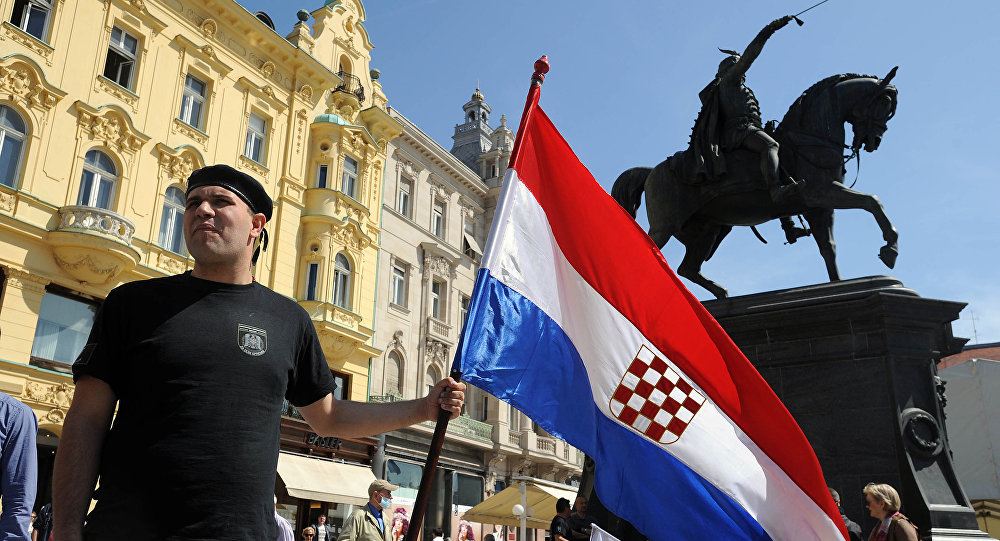 EuroCroatia today: Ban Jelačić’s Square in Zagreb. A neo–Ustashi with the WWII flag of a Nazifascist Independent State of Croatia
EuroCroatia today: Ban Jelačić’s Square in Zagreb. A neo–Ustashi with the WWII flag of a Nazifascist Independent State of Croatia
The HDZ’s economic policy was as well framed for the sake to subordinate state economy to a state-building task. For that reason, the members of HDZ supported an idea and practice of significant state ownership that was also in odd to the Western liberalism. However, in the HDZ’s Croatia a process of corruption and taycoonization of economic resources and infrastructure by well-placed HDZ’s political leaders was a well-known practice which led to their personal and family enrichment.
As a part of the anti-liberal policy, the liberal-democratic notion of the citizenship was crucially challenged by the HDZ’s ruling authority as the voting rights for the state and the other public officials became based on the ethnic (Croat) background rather than on the residence criteria. Therefore, it was practically reserved twelve seats in Croatia’s Parliament for the ethnic Croat diaspora for the very reason that the HDZ was and is traditionally supported by the Croat diaspora, especially from Bosnia-Herzegovina. The citizenship law was also changed in the favor of the ethnic Croat diaspora as Croatia was proclaimed as the motherland of all ethnic Croats.[18] However, a similar ethno-citizenship/voting law in Miloshevic’s Serbia was never introduced at least for the very political reason that the Serb diaspora in the West opposed his policy as anti-Serbian. In other words, Miloshevic’s Serbia was seen, by the Constitution, as a homeland of all her inhabitants, rather than only of all ethnic Serbs wherever they live.
Probably, the HDZ’s deny of any kind of regional autonomy in Croatia was the expression of the policy of anti-liberal democracy concept of minority rights. Therefore, the regional parties of Istria, (the Serb populated) Krajina and Dalmatia suffered mostly from such policy of a brutal centralization of Croatia. However, in Miloshevic’s Serbia, two regions of Vojvodina and Kosovo-Metochia enjoyed at least ethnocultural regional autonomy if not a political one as it was fixed at the time of the Socialist Federal Republic of Yugoslavia according to the 1974 Constitution (up to 1989).
In general, the Croat ultranationalists were against the basic values of the Western liberalism but also and against many segments of the Western culture especially of the U.S. as they perceived such culture as an attempt to destroy the authentic values of the Croat nation. The West became accused and for the attempts to undermine the independence of Croatia and even to recreate some form of the Yugoslav (or Balkan) confederation with the Serbs and Serbia. Therefore, the U.N.’s UNPROFOR’s detachments, deployed on the territory of the Republic of Serb Krajina (as the U.N.’s protection zone) were called to be removed from the territory of Croatia as the main obstacle for her territorial reunification. Nevertheless, Croatia became finally reunited within the borders of a Greater Croatia of Josip Broz Tito after the WWII when Croatia’s military and police reoccupied the territory of Krajina in August 1995 under the blessing of both the U.S.’s administration and the UNPROFOR’s command. Therefore, for the Croat ultranationalists, the suspicions of possible Western designs to recreate a form of Yugoslavia disappeared after the operation “Storm” but their suspicions to the Western political liberalism and cultural and social values of the liberal ideology are present up today.
Conclusion
The internal and external destruction of the former Yugoslavia in the 1990s was celebrated in 2015 its 20th years of anniversary. However, this historical event still needs a satisfactory research approach in regard to the true geopolitical reasons and political-military course of the destruction of this South Slavic and Balkan state. During the last quarter of a century, the (Western) global mainstream media and academia unanimously accused Serbia and the Serbs for the national chauvinism as the main cause of the bloody wars on the territory of ex-Yugoslavia in the 1990s.[19] However, the role and direct impact of the other Yugoslav republics and nations in the process of killing the common state was not taken (purposely) into the consideration; especially of the Croats and Croatia as the biggest nation and republic after the Serbs and Serbia. This article is an attempt to contribute to the full-scale of understanding of the process of destruction of the former Yugoslavia taking into the account the role of the Croats and Croatia.
Franjo Tudjman’s authoritarian regime in Croatia and the territorial expansionist policy of his HDZ’s ruling party during the bloody destruction of the former Yugoslavia in the 1990s were not noticed at all by the Western politicians, academicians and the global mass-media who, in contrast, accused “dictator”-President of Serbia Slobodan Miloshevic (a “Balkan butcher”) for the policy of creation of a Greater Serbia, Serbia’s aggression on Croatia and Bosnia-Herzegovina and later for the practice of ethnic cleansing in Kosovo-Metochia. However, the main causer of the destruction of ex-Yugoslavia was not Slobodan Milosevic but rather Dr. Franjo Tudjman in Croatia who introduced tougher dictatorship than Miloshevic in Serbia with the fundamental political goal to establish ethnically pure a Greater Croatia within the ethnohistorical borders of the Croat nation as proclaimed by the ultranationalist Croat ideologists in the 19th and the 20th century. His efforts in the process of state-building of Croatia in the 1990s were aimed to nationalize the state in which the political and cultural dominant position of the ethnic Croats has been reserved. In essence, after the 1990 elections in Croatia, a new political leadership adopted a state-building form and methods which have been crucially against the process of real democratization of political life and society in this ex-Yugoslav republic. Their ideology and implementation strategy were derived from the 19th and 20th-century Croat ultranationalism and legitimized by appropriating the symbols and iconography of the most extremist and even Nazi-Fascist (the Ustashi) Croat nationalistic movements.
The ultraright-wing ideology on which the state-building process was executed in Croatia in the 1990s was fundamentally anti-liberal and above all anti-Serb. In order to solve, as proclaimed, the most important problem in Croatia – the “Serb Question”, Croatia’s authorities privileged national (ethnic Croat) rights over the individual rights, ethnic (Croat) state over the civic multicultural society and political authoritarianism instead of institutional democracy. As the Croat ultranationalistic ideology was and is based on both ethnic and historic rights of the Croats for the sake to create a united Greater Croatia, a direct involvement of regular Croatia’s military forces alongside with the ethnic Croat paramilitary militia in the civil war in Bosnia-Herzegovina against the Serbs and Muslim Bosniaks was inevitable. The ethnic cleansing of certain Bosnian-Herzegovinian territories (a Croat proclaimed the “Republic of Herzeg-Bosnia”) by the Croat forces, directly or indirectly sponsored by the Government in Zagreb, was done for the very purpose to finally include those territories into ethnically pure Greater Croatia.
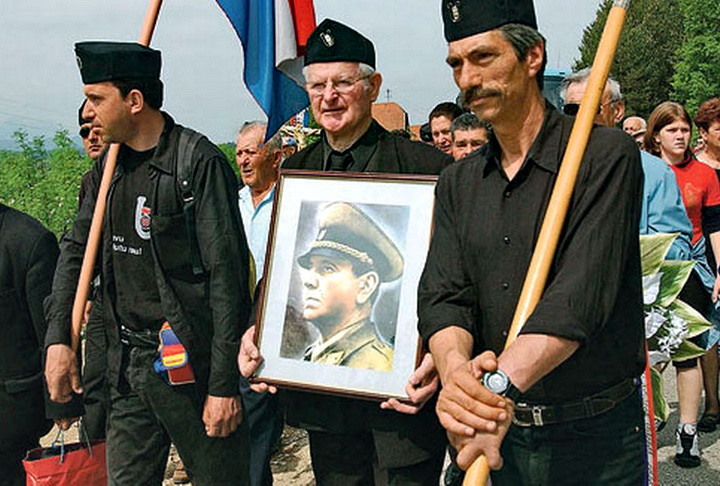 F. Tudjman’s Croatia: A reborn WWII Ustashi Nazifascism
F. Tudjman’s Croatia: A reborn WWII Ustashi Nazifascism
sotirovic1967@gmail.com
© Vladislav B. Sotirovic 2018
Personal disclaimer: The author writes for this publication in a private capacity which is unrepresentative of anyone or any organization except for his own personal views. Nothing written by the author should ever be conflated with the editorial views or official positions of any other media outlet or institution.
References:
[1] The Banovina Hrvatska had a territory of 65.456 square km. with 4.024.601 inhabitants according to the 1931 census. It was composed by 70.1 percent of the Croats, 19.1 percent of the Serbs, 3.6 percent of the Bosnian-Herzegovinian Muslims (today the Bosniaks) and 7.2 percent of the others (mainly the Germans and the Hungarians). It consisted of the territories of Croatia proper, Slavonia, the West Srem, Dalmatia, Dubrovnik, the West Herzegovina, the parts of the Central Bosnia and the parts of the North Bosnia [S. Srkulj, J. Lučić, Hrvatska Povijest u dvadeset pet karata. Prošireno i dopunjeno izdanje, Zagreb: Hrvatski informativni centar, 1996, 101−103]. The Banovina Hrvatska was created under the British diplomatic pressure to solve the “Croat Question” in Yugoslavia before the German aggression. The final political agreement on the creation of Banovina Hrvatska and her borders was reached by two Yugoslav politicians – one Croat (Vlatko Machek, a leader of the Croat opposition) and one Gypsy/Roma (Dragiša Cvetković, a Yugoslav Prime Minister). The ethnic Serb politicians did not participate in the negotiations on the agreement and strongly opposed it.
[2] In the eyes of some Croat ultranationalists, even the Bay of Kotor in Montenegro as well Bachka and Sanjak from Serbia were seen as the parts of the ethnohistorical Croatia.
[3] Profil, 1992-08-03.
[4] On the Dayton Accords, see: D. Chollet, The Road to the Dayton Accords: A Study of American Statecraft, New York: Palgrave MacMillan, 2005.
[5] The “Croat Community of Herzeg-Bosnia” (the HZHB) was proclaimed on July 3rd, 1992 that is three months after the outbreak of the civil war in Bosnia-Herzegovina. The Herzeg-Bosnia became, in fact, a “South Croatia” and just formally part of Bosnia-Herzegovina [J. Guskova, Istorija jugoslovenske krize (1990−2000), 1, Beograd: Izdavački grafički atelje “M”, 2003, 368−369]. However, the HZHB was on August 28th, 1993 proclaimed as the Croat Republic of Herzeg-Bosnia (the HRBH) with a political aim to be united with the Republic of Croatia.
[6] The same ethnopolitical role of national coherence played anti-Semitism in the ideology of Nazi Germany. In the Croat case, the anti-Semitism was not an important factor in the ultranationalist ideology, at least up to the WWII.
[7] For instance, see: J. Jareb, Pola stoljeća hrvatske politike: Povodom Mačekove autobiografije, Zagreb: Institut za suvremenu povijest, 1995, V−X.
[8] Foreign Broadcast Information Service, Daily Report: Eastern Europe, 1995-08-10.
[9] Temeljna načela i statut, Hrvatska stranka prava, 1991-02-24.
[10] Interview with Ante Djapic, Glas Slavonije, 1995-08-19.
[11] В. Ђ. Мишина (уредник), Република Српска Крајина: Десет година послије, Београд: Добра воља, 2005, 48.
[12] J. Guskova, Istorija jugoslovenske krize (1990−2000), 1, Beograd: Izdavački grafički atelje “M”, 2003, 223.
[13] J. A. Irvine, “Ultranationalist Ideology and State-Building in Croatia, 1990−1996”, Problems of Post-Communism, July/August 1997, 40. It is clear from the transcripts of the meeting between Croatia’s Government and military officials at Brioni just before the operation “Storm” started that Tudjman’s requirement was that the Serbs have to disappear from Croatia [http://www.nspm.rs/dokumenti/tudjmanovi-brionski-transkripti-udariti-srbe-da-nestanu.html].
[14] On the present-day territory of Croatia, there was 24 percent of the Serbs before the WWII.
[15] That Croatia’s Government launched the war against the Serbs in 1991 in order to provoke them is confirmed by Tudjman’s first minister of police, Josip Boljkovac in his interview in 2014 [http://www.jugoslavologija.eu/2014/12/24/tudmanov-ministar-priznao-prvi-smo-napali-srbe-da-bi-poceo-rat/].
[16] On the Western liberalism, see [L. Mises, Liberalism in the Classical Tradition, San Francisco, California: Cobden Press, 1985; E. Fawcett, Liberalism: The Life of an Idea, Princeton, NJ: Princeton University Press, 2014; M. Freeden, Liberalism: A Very Short Introduction, Oxford, UK: Oxford University Press, 2015].
[17] F. Tudjman, S vjerom u samostalnu Hrvatsku, Zagreb: Narodne novine, 1995, 79−90.
[18] On the concept of citizenship, see: W. Kymlicka, Multicultural Citizenship: A Liberal Theory of Minority Rights, Oxford−New York: Oxford University Press, 1995; R. Bellamy, Citizenship: A Very Short Introduction, Oxford−New York: Oxford University Press, 2008; É. Balibar, Citizenship, Cambridge, UK−Malden, USA: Polity Press, 2015. The same citizenship concept, for example, is accepted by all three Baltic States after the collapse of the Soviet Union: Estonia, Latvia, and Lithuania.
[19] For instance [L. Silber, A. Little, Yugoslavia: Death of a Nation, London: Penguin Books, 1997; L. Sell, Slobodan Milosevic and the Destruction of Yugoslavia, Durham−London: Duke University Press, 2003].

Origins of images: Facebook, Twitter, Wikimedia, Wikipedia, Flickr, Google, Imageinjection & Pinterest.
Read our Disclaimer/Legal Statement!
Donate to Support Us
We would like to ask you to consider a small donation to help our team keep working. We accept no advertising and rely only on you, our readers, to keep us digging the truth on history, global politics and international relations.
 A grave-stone full of fascist (Ustasha) symbols in a cemetery of the Croatian town of Samobor
A grave-stone full of fascist (Ustasha) symbols in a cemetery of the Croatian town of Samobor




